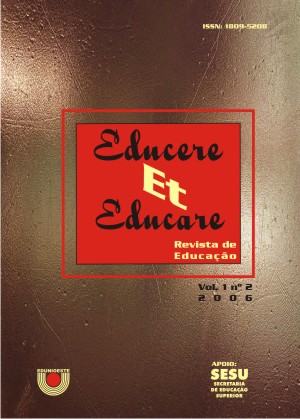PLANFOR, REFORMA DO ESTADO E ACUMULAÇÃO FLEXÍVEL: TECENDO FIOS INVISÍVEIS
DOI:
https://doi.org/10.17648/educare.v1i2.266Parole chiave:
PLANFOR, reforma do Estado brasileiro, acumulação flexívelAbstract
O trabalho expõe as principais revelações de uma pesquisa que tomou o PlanoNacional de Qualificação do Trabalhador (PLANFOR) como objeto de análise. Seguindo a metodologia dialética e tendo como categorias básicas a contradição e a mediação, este estudo identificou a existência de “fios invisíveis” que ligaram o PLANFOR a processos relacionados à atual configuração dos processos de reprodução do capital e do Estado neoliberal.
Por meio da exploração de contradições internas ao PLANFOR, o estudo permitiu concluir que o Plano atuou como instrumento de regulação social, organicamente vinculado com a consolidação do Estado neoliberal – pela mercantilização das relações entre o Estado estrito senso e a sociedade civil –, e com o regime flexível de acumulação capitalista – pela afirmação da possibilidade do financiamento público da reprodução ampliada do capital.
Downloads
Pubblicato
07-12-2007
Come citare
SOBREIRA DOS SANTOS CÊA, G. PLANFOR, REFORMA DO ESTADO E ACUMULAÇÃO FLEXÍVEL: TECENDO FIOS INVISÍVEIS. Educere et Educare, [S. l.], v. 1, n. 2, p. p. 229–244, 2007. DOI: 10.17648/educare.v1i2.266. Disponível em: https://saber.unioeste.br/index.php/educereeteducare/article/view/266. Acesso em: 19 dic. 2025.
Fascicolo
Sezione
Artigos e Ensaios
Licenza
Aviso de Direito Autoral Creative Commons
Política para Periódicos de Acesso Livre
Autores que publicam nesta revista concordam com os seguintes termos:
1. Autores mantém os direitos autorais e concedem à revista o direito de primeira publicação, com o trabalho simultaneamente licenciado sob a Licença Creative Commons Attribution que permite o compartilhamento do trabalho com reconhecimento da autoria e publicação inicial nesta revista.2. Autores têm autorização para assumir contratos adicionais separadamente, para distribuição não-exclusiva da versão do trabalho publicada nesta revista (ex.: publicar em repositório institucional ou como capítulo de livro), com reconhecimento de autoria e publicação inicial nesta revista.
3. Autores têm permissão e são estimulados a publicar e distribuir seu trabalho online (ex.: em repositórios institucionais ou na sua página pessoal) a qualquer ponto antes ou durante o processo editorial, já que isso pode gerar alterações produtivas, bem como aumentar o impacto e a citação do trabalho publicado (Veja O Efeito do Acesso Livre).
Licença Creative Commons
Esta obra está licenciada com uma Licença Creative Commons Atribuição-NãoComercial-CompartilhaIgual 4.0 Internacional, o que permite compartilhar, copiar, distribuir, exibir, reproduzir, a totalidade ou partes desde que não tenha objetivo comercial e sejam citados os autores e a fonte.


